Vulnerability to Flood Risk: A Methodological Proposal for Assessing the Isolation of the Population
Abstract
:1. Introduction
- The zoning of exposure to forest fires establishes the first mapping strategies to assess the isolation of populated areas. Many methods to assess the vulnerability of settlements focus on aspects such as accessibility [45,46,47,48,49,50], and specifically, on the possibility of isolation by fire [51,52].
- In the case of the floods in Bangladesh, Lu et al. [55] raise the problem of isolation as one of the most negative consequences of flooding, since this isolation can lead to the cancellation of trips and the selection of other destinations. In order to tackle this problem, they propose the improvement of water infrastructure and education to adapt to floods. In Peru, Thouret et al. [56] also consider the isolation factor for lahars and flash floods at a building scale. To do so, they take into account the distances from each building to the facilities that are required during an emergency (e.g., hospitals or shelters). At the same scale of detail, Fujiki and Laleau [57] test a GIS methodology to identify emergency shelter needed by flood-affected populations. In this case, they combine two indexes, the first an exposure index that involves different variables related to the characteristics of the hazard and its direct physical impacts: flood height, geographical isolation, interruption of public services.
- Finally, there are studies that deal with the vulnerability of road infrastructure, such as those carried out by Othman and Hamid [58], He et al. [59] and Kim et al. The authors of [60] also propose a methodology for the simulation of cut-off areas, making clear in their case the special vulnerability of suburban areas. Finally, other works have advanced modeling solutions to help the management of the road system when a flood event occurs [61,62,63].
- Diagnosis of the population with the possibility of being isolated within the flooded area.
- Diagnosis of the population likely to be isolated by cuts in access roads outside the flood zone.
- Diagnosis of the main workplaces involving concentrations of population likely to be isolated.
2. Materials and Methods
2.1. Study Area
2.2. Elaboration of the Methodological Proposal
- Isolation of the population;
- Disruption of basic territorial services;
- Relief and assistance challenges;
- Risky or unsafe behavior of the population;
- Effects on particularly sensitive goods or sectors of the territory;
- Contamination of parts of the territory and other risks associated with flooding.
- Map of population with possibility of being isolated within the flooded area according to its degree of isolation;
- Map of population outside the flood-prone area that may be isolated by roadblocks, depending on their degree of isolation;
- Map of main workplaces involving concentrations of population likely to be isolated (industrial, services) according to their degree of isolation.
2.3. Sources of Information
- DERA: Spatial Reference Data of Andalusia. Scale 1:100,000. Year: 2021. This is a cartographic database with a wide range of spatial data. This information is very useful for the selection of potentially affected territorial elements. It has been used in the methodology of the three maps included in the study.
- SIOSE: Land use/land cover information system of Spain. Scale 1:10,000. Year 2007. This special database allows categorizing land uses according to their function (industrial, residential, agricultural, etc.). It has been used in the elaboration of the map methodology of Section 2.4.3.
- CartoCiudad: Road network of Spain. Several scales. Year: 2021. This is a dataset of the urban and interurban road network. It is used to measure the internal connectivity of the nuclei and their interconnectivity. This information is used in the elaboration of the three maps.
- Cadastre: Cadastral electronic site. Variable scale. Year: 2021. Cartographic and alphanumeric information database belonging to the official Spanish Cadastre. The cartographic base of the buildings has been used, which has allowed disaggregating the estimated population per floor. The information has been necessary for the creation of two maps: Section 2.4.1 and Section 2.4.3
- GoogleEarth. Variable scale. Year: 2021. Multi-scale orthophotography service. It has been consulted for photointerpretation. Its Google Street View extension, which provides street-level panoramic views, has also been consulted. These sources have been used in the elaboration and correction of territorial elements of the cartography.
- PNOA: National Aerial Orthophoto Plan of Spain. Year 2021. Orthophotography service. It has been used for photointerpretation and cartographic elaboration.
- Hydrological plans. Variable scale. Years: According to water authorities of the basins. Documents prepared by the water authorities that set out the guidelines to be followed for water management in each river basin. The cartographic bases of flood spots belonging to the flood risk management plan of the Andalusian Mediterranean Basins have been used. This information has been taken into account in the preparation of all the maps.
- INE: Spanish National Statistical Institute. Spanish Continuous Register 2021. Demographic information on the population is extracted from this source. This information is considered in the preparation of maps methodology from Section 2.4.1 and Section 2.4.2
2.4. Structure of the Methodology
2.4.1. Map of the Population Likely to Be Isolated within the Flooded Area According to Its Degree of Isolation
- Step 1: Selection of territorial elements involved in the map development.
- Step 2: Selected Territorial Elements and their Degree of Damage by flood
- Step 3: Establishing the degree of vulnerability of the affected territorial elements.
- Very high vulnerability: Buildings with a moderate and a high population of people that are affected by flooding. Additionally, if the number of the affected population is high and it is isolated, they are included in this category.
- High vulnerability: Areas with low population concentration in buildings, but with a maximum degree of isolation due to flooding. This category also includes areas with moderate accumulation of people being isolated and not “flooded”.
- Moderate vulnerability: This category only includes areas with low and isolated population density.
2.4.2. Map of the Population Outside the Flooded Area That May Be Isolated by Roadblocks According to Its Degree of Isolation
- Step 1: Selection of territorial elements involved in the development of the map.
- Step 2: Territorial elements selected and their degree of damage because of flooding.
- Step 3: Establishing the degree of vulnerability of the affected territorial elements.
2.4.3. Map of the Main Workplaces with Concentrations of Population Likely to Be Isolated (Industrial, Services) According to Their Degree of Isolation
- Step 1: Selection of territorial units involved in the development of the map.
- Step 2: Territorial elements selected and their degree of damage because of flooding.
- Step 3: Categorization of workplaces.
- Small workplaces: 0–50 m2,
- Medium-sized workplaces: 50–500 m2,
- Large workplaces: >500 m2.
- Step 4: Establishing the degree of vulnerability of the affected territorial elements.
3. Results
3.1. Mapping the Population Likely to Be Isolated within the Flooded Area
3.2. Diagnostic Mapping of the Population Susceptible to Being Isolated by Cuts of Roads Outside the Flooded Area
3.3. Mapping of the Main Workplaces with Population Concentrations Likely to Be Isolated
4. Discussion
5. Conclusions
Author Contributions
Funding
Acknowledgments
Conflicts of Interest
References
- Pita López, M.F. Riesgos Catastróficos y Ordenación Del Territorio En Andalucía; Consejería de Obras Públicas y Transportes; Junta de Andalucía: Sevilla, Spain, 1999. [Google Scholar]
- Olcina Cantos, J. Conceptos de Aplicación En El Análisis de Riesgos. In Riesgos Naturales; Ariel: Barcelona, Spain, 2002. [Google Scholar]
- Ribera, L. Los Mapas de Riesgo de Inundaciones: Representación de La Vulnerabilidad y Aportación de Las Innovaciones Tecnológicas. Doc. Análisis Geográfico 2004, 43, 153–171. [Google Scholar]
- Perles Roselló, M.J. Apuntes Para La Evaluación de La Vulnerabilidad Social Frente Al Riesgo de Inundación. Baética. Estud. Arte Geogr. Hist. 2010, 32, 67–87. [Google Scholar]
- Cantarero Prados, F.J.; Oropeza Orozco, O.; Perles Roselló, M.J. Carencias y Necesidades de Investigación Sobre Vulnerabilidad Frente a Las Inundaciones En México. In XV Coloquio Ibérico de Geografía. Retos y Tendencias de la Geografía Ibérica; Asociación de Geógrafos Españoles: Murcia, Spain, 2016; pp. 108–117. [Google Scholar]
- van Aalst, M.K. The Impacts of Climate Change on the Risk of Natural Disasters. Disasters 2006, 30, 5–18. [Google Scholar] [CrossRef] [PubMed]
- Schmidt-Thome, P.; Greiving, S. The response to natural hazards and climate change in Europe. Investig. Geográficas 2009, 49, 23–49. [Google Scholar] [CrossRef] [Green Version]
- Stults, M. Integrating Climate Change into Hazard Mitigation Planning: Opportunities and Examples in Practice. Clim. RISK Manag. 2017, 17, 21–34. [Google Scholar] [CrossRef]
- Cantarero Prados, F.J. Relaciones Entre El Patrón Territorial y La Generación Del Peligro de Inundación. Análisis Comparado de Casos En Málaga (España) y Motozintla (México), Universidad de Málaga. 2013. Available online: https://www.educacion.gob.es/teseo/mostrarRef.do?ref=1036662 (accessed on 3 November 2021).
- Gallegos Reina, A. Caracterización de Cuencas Fluviales Periurbanas Con Riesgo de Inundación En Ámbitos Mediterráneos y Propuesta de Cartografía de Peligrosidad Adaptada, Universidad de Málaga. 2015. Available online: https://www.educacion.gob.es/teseo/mostrarRef.do?ref=1176072 (accessed on 4 November 2021).
- Gallegos Reina, A.; Perles Roselló, M.J. Relationships between Peri-Urbanization Processes and Multi-Hazard Increases: Compared Diachronic Analysis in Basins of the Mediterranean Coast. ISPRS Int. J. Geo Inf. 2021, 10, 759. [Google Scholar] [CrossRef]
- Perles Roselló, M.J.; Mérida Rodríguez, M. Patrón Territorial y Conformación Del Riesgo En Espacios Periurbanos. El Caso de La Periferia Este de La Ciudad de Málaga. Scr. Nova. Rev. Electrónica Geogr. Ciencias Soc. 2010, 14, 199983. [Google Scholar]
- Castronovo, R. La Ocupación del Territorio y Sus Aspectos Ambientales. Análisis de un Sistema Periurbano. In VI Encuentro de Geografía de América Latina; Temas Libres: Buenos Aires, Argentina, 1997; p. 7. [Google Scholar]
- Okunola, O.H.; Bako, A.I. Exploring Residential Characteristics as Determinants of Household Adaptation to Climate Change in Lagos, Nigeria. Int. J. Disaster Resil. Built Environ. 2021. ahead-of-print. [Google Scholar] [CrossRef]
- Spears, E. Reconceptualizing Social Vulnerability in Brunswick, Georgia: Critical Physical Geography and the Future of Sea-Level Rise. Southeast. Geogr. 2021, 61, 357–380. [Google Scholar] [CrossRef]
- UNDRO. Natural Disasters and Vulnerability Analysis. Report of Expert Group Meeting; Office of the United Nations Disaster Relief Coordinator: New York, NY, USA, 1980. [Google Scholar]
- Timmerman, P. Vulnerability, resilience and the collapse of society. In A Review of Models and Possible Climatic Applications; Institute for Environmental Studies, University of Toronto: Toronto, ON, Canada, 1981. [Google Scholar]
- Maskrey, A. Community Based Hazard Mitigation. In Proceedings of the International Conference on Disaster Mitigation Program Implementation, Ocho Rios, Jamaica, 12–16 November 1983. [Google Scholar]
- Cardona, O.D. Enfoque Metodológico Para La Evaluación de La Amenaza, Vulnerabilidad y Riesgo Sísmico. In Memorias del Seminario Nacional Sobre Prevención y Manejo de Catástrofes Naturales; Asociación de Ingenieros Estructurales: Medellín, Columbia, 1986. [Google Scholar]
- Cardona, O.D. Proyecto Integral de Mitigación de Riesgo Sísmico Urbano. In VI Seminario Latinoamericano de Ingeniería Sismo-resistente; Universidad Autónoma Metropolitana: Ciudad de México, México, 1990. [Google Scholar]
- Liverman, D.M. Vulnerability to Global Environmental Change. In Understanding Global Environmental Change: The Contributions of Risk Analysis and Management; Kasperson, R.E., Dow, K., Golding, D., Eds.; Center for Technology, Environment, and Development, Clark University: Worcester, UK, 1990; pp. 27–44. [Google Scholar]
- Cannon, T. Vulnerability Analysis and The Explanation Of “Natural” Disasters. In Disasters, Development and Environment; John Wiley & Sons Ltd.: Hoboken, NJ, USA, 1994; Available online: https://www.researchgate.net/publication/248360551_Vulnerability_Analysis_and_The_Explanation_Of_%27Natural%27_Disasters (accessed on 3 November 2021).
- Cannon, T. Vulnerability Analysis, Livelihoods and Disasters. In RISK21—Coping with Risks Due to Nat. Hazards 21st Century; CRC Press: Boca Raton, FL, USA, 2006; pp. 41–49. [Google Scholar] [CrossRef]
- Blaikie, P.; Cannon, T.; David, I.; Wisner, B. Vulnerabilidad, El Entorno Social, Político y Económico de Los Desastres; Red de Estudios Sociales en Prevención de Desastres en América Latina: Puerto Limón, Costa Rica, 1996. [Google Scholar]
- UNISDR. Living with Risk: A Global Review of Disaster Reduction Initiatives; United Nations Publications: New York, NY, USA, 2004; Volume 1. [Google Scholar]
- UNISDR. Global Assessment Report on Disaster Risk Reduction (2009); United Nations Office for Disaster Risk Reduction: Geneva, Switzerland, 2009; ISBN 9789211320282. Available online: https://www.undrr.org/publication/global-assessment-report-disaster-risk-reduction-2009 (accessed on 6 November 2021).
- UNU-EHS. Expert Working Group on Measuring Vulnerability. Measuring Vulnerability to Natural Hazards; Birkmann, J., Ed.; United Nations University—Institute for Environment and Human Security: Bonn, Germany, 2013. [Google Scholar]
- Birkmann, J.; Wisner, B. Measuring the Unmeasurable: The Challenge of Vulnerability; United Nations University—Institute for Environment and Human Security: Bonn, Germany, 2006; Volume 5, Available online: http://www.ehs.unu.edu/file.php?id=212 (accessed on 5 November 2021).
- Birkmann, J.; Kienberger, S.; Alexander, D.E. Assessment of Vulnerability to Natural Hazards: A European Perspective; Elsevier Inc.: Amsterdam, The Netherlands, 2014. [Google Scholar] [CrossRef]
- Birkmann, J.; Jamshed, A.; McMillan, J.M.; Feldmeyer, D.; Totin, E.; Solecki, W.; Ibrahim, Z.Z.; Roberts, D.; Kerr, R.B.; Poertner, H.-O.; et al. Understanding Human Vulnerability to Climate Change: A Global Perspective on Index Validation for Adaptation Planning. Sci. Total Environ. 2022, 803, 150065. [Google Scholar] [CrossRef]
- Cutter, S.L.; Boruff, B.J.; Shirley, W.L. Social Vulnerability to Environmental Hazards. Soc. Sci. Q. 2003, 84, 242–261. [Google Scholar] [CrossRef]
- Cutter, S.L.; Finch, C. Temporal and Spatial Changes in Social Vulnerability to Natural Hazards. Proc. Natl. Acad. Sci. USA 2008, 105, 2301–2306. [Google Scholar] [CrossRef] [PubMed] [Green Version]
- Cardona, O.D.; Van Aalst, M.K.; Birkmann, J.; Fordham, M.; Mc Gregor, G.; Rosa, P.; Pulwarty, R.S.; Schipper, E.L.F.; Sinh, B.T.; Décamps, H.; et al. Determinants of Risk: Exposure and Vulnerability. Manag. Risks Extrem. Events Disasters to Adv. Clim. Chang. Adapt. Spec. Rep. Intergov. Panel Clim. Chang. 2012, 9781107025066, 65–108. [Google Scholar] [CrossRef] [Green Version]
- Alfieri, L.; Bisselink, B.; Dottori, F.; Naumann, G.; de Roo, A.; Salamon, P.; Wyser, K.; Feyen, L. Global Projections of River Flood Risk in a Warmer World. Earths Futur. 2017, 5, 171–182. [Google Scholar] [CrossRef]
- Lyu, H.-M.; Sun, W.-J.; Shen, S.-L.; Arulrajah, A. Flood Risk Assessment in Metro Systems of Mega-Cities Using a GIS-Based Modeling Approach. Sci. Total Environ. 2018, 626, 1012–1025. [Google Scholar] [CrossRef]
- O’Shea, T.E.; Lewin, J. Urban Flooding in Britain: An Approach to Comparing Ancient and Contemporary Flood Exposure. Nat. Hazards 2020, 104, 581–591. [Google Scholar] [CrossRef]
- Komolafe, A.A.; Awe, B.S.; Olorunfemi, I.E.; Oguntunde, P.G. Modelling Flood-Prone Area and Vulnerability Using Integration of Multi-Criteria Analysis and HAND Model in the Ogun River Basin, Nigeria. Hydrol. Sci. J. 2020, 65, 1766–1783. [Google Scholar] [CrossRef]
- Tate, E.; Rahman, M.A.; Emrich, C.T.; Sampson, C.C. Flood Exposure and Social Vulnerability in the United States. Nat. Hazards 2021, 106, 435–457. [Google Scholar] [CrossRef]
- Consejería de Obras Públicas y Transportes. Decreto 189/2002, de 2 de Julio, Por el que se Aprueba el Plan de Prevención de Avenidas e Inundaciones en Cauces Urbanos Andaluces. BOJA núm. 91 de 3 de Agosto de 2002. Available online: https://www.juntadeandalucia.es/boja/2002/91/5 (accessed on 11 November 2021).
- Generalitat Valenciana. Plan de Acción Territorial de carácter sectorial sobre prevención del Riesgo de Inundación en la Comunitat Valenciana. Acuerdo de 28 de enero de 2003, del Consell de la Generalitat, por el Que Se Aprueba Definitivamente el Plan de Acción Territorial de Carácter Sectorial Sobre Prevención del Riesgo de Inundación en la Comunidad Valenciana. 2003. DOGV num. 4429 de 30 January 2003. 2003. Available online: https://politicaterritorial.gva.es/es/web/planificacion-territorial-e-infraestructura-verde/patricova-plan-de-accion-territorial-de-caracter-sectorial-sobre-prevencion-del-riesgo-de-inundacion-en-la-comunitat-valenciana (accessed on 11 November 2021).
- Generalitat de Cataluña. Plan especial de emergencias por inundaciones de Cataluña (INUNCAT). Acuerdo GOV/14/2015, de 10 de febrero, por el que se aprueba la revisión del Plan especial de emergencias por inundaciones de Cataluña (INUNCAT). Available online: https://noticias.juridicas.com/base_datos/CCAA/ca-l4-1997.html (accessed on 11 November 2021).
- Región de Murcia. Plan de Ordenación Territorial del Litoral de la Región de Murcia. Decreto 57/2004, de 18 Junio, Aprueba las «Directrices y Plan de Ordenación Territorial del Litoral de la Región de Murcia». Consejería Turismo Y Ordenación Del Territorio BO. Región de Murcia 25 junio 2004, núm. 145, Pág. 14167. Available online: https://www.borm.es/services/anuncio/ano/2004/numero/8885/pdf?id=30026 (accessed on 11 November 2021).
- Gobierno de Castilla-La Mancha. Plan Especial de Protección Civil ante el Riesgo de Inundaciones de Castilla La Mancha (PRICAM). Decreto 36/2013, de 04/07/2013, por el que se Regula La Planificación De Emergencias en Castilla-La Mancha y se aprueba la revisión del Plan Territorial de Emergencia de Castilla-La Mancha. Available online: https://www.castillalamancha.es/sites/default/files/documentos/pdf/20150615/memoria_pricam_i_rev._2015.pdf (accessed on 11 November 2021).
- Perles, M.J.; Sortino, J.F.; Cantarero, F. Cartografía de la vulnerabilidad del territorio frente al riesgo de inundación. Propuesta adaptada a la Directiva europea de inundaciones y normativas derivadas. Bol. Asoc. Geógr. Esp. 2017, 75, 341–372. [Google Scholar] [CrossRef] [Green Version]
- Cova, T.J.; Church, R.L. Modelling Community Evacuation Vulnerability Using GIS. Int. J. Geogr. Inf. Sci. 1997, 11, 763–784. [Google Scholar] [CrossRef]
- Cova, T.J.; Johnson, J.P. Microsimulation of Neighborhood Evacuations in the Urban–Wildland Interface. Environ. Plan. 2002, 34, 2211–2229. [Google Scholar] [CrossRef]
- Cova, T.J. Public Safety in the Urban–Wildland Interface: Should Fire-Prone Communities Have a Maximum Occupancy? Nat. Hazards Rev. 2005, 6, 99–108. [Google Scholar] [CrossRef]
- Camia, A.; Varela, V.; Marzano, R.; Eftichidis, G. Spatial Analysis in European Wildland-Urban Interface Environments Using GIS. In Proceedings of the International Scientific Workshop on “Forest Fires in the Wildland-Urban Interface and Rural Areas in Europe: An Integral Planning and Management Challenge”, Athens, Greece, 15–16 May 2003; pp. 185–196. [Google Scholar]
- Beltrán, I.; Ruiz, E.; Sanchez, R.; Pascual, C. A Method to Classify W-UI Situations in Europe: Towards a Common Catalogue. In Proceedings of the International Scientific Workshop on “Forest Fires in the Wildland-Urban Interface and Rural Areas in Europe: An Integral Planning and Management Challenge”, Athens, Greece, 15–16 May 2003; pp. 55–66. [Google Scholar]
- Moraga Peralta, J.C. Forest Fire Risk Assessment in Tempisque River Basin, COSTA RICA. Rev. Geogr. Am. Cent. 2010, 45, 33–64. [Google Scholar]
- Caballero, D. Wildland-Urban Interface Management: A State of the Art. Document EVR1-CT-2002-40028 D-10-01. WARM Project. 2002. Available online: www.eufirelab.org (accessed on 13 November 2021).
- Xanthopoulos, G. Factors Affecting the Vulnerability of Houses to Wildland Fire in the Mediterranean Region. In Proceedings of the International Scientific Workshop on “Forest Fires in the Wildland-Urban Interface and Rural Areas in Europe: An Integral Planning and Management Challenge”, Athens, Greece, 15–16 May 2003; pp. 85–92. [Google Scholar]
- Michael-Leiba, M.; Scott, G.; Baynes, F.; Granger, K. Quantitative Landslide Risk Assessment of Cairns, Australia. In Geotechnical Engineering Meeting Society’s Needs, Proceedings, of the Fourteenth Southeast Asian Geotechnical Conference, Hong Kong, 10–14 December 2001; CRC Press: Boca Raton, FL, USA, 2001; Volumes 1 and 2, pp. 149–154. [Google Scholar]
- Michael-Leiba, M.; Baynes, F.; Scott, G.; Granger, K. Regional Landslide Risk to the Cairns Community. Nat. Hazards 2003, 30, 233–249. [Google Scholar] [CrossRef]
- Lu, Q.C.; Zhang, J.; Peng, Z.R.; Rahman, A.S. Inter-city travel behaviour adaptation to extreme weather events. J. Transp. Geogr. 2014, 41, 148–153. [Google Scholar] [CrossRef]
- Thouret, J.-C.; Enjolras, G.; Martelli, K.; Santoni, O.; Luque, J.A.; Nagata, M.; Arguedas, A.; Macedo, L. Combining Criteria for Delineating Lahar- and Flash-Flood-Prone Hazard and Risk Zones for the City of Arequipa, Peru. Nat. Hazards Earth Syst. Sci. 2013, 13, 339–360. [Google Scholar] [CrossRef]
- Fujiki, K.; Laleau, M. A geographic approach for spatializing emergency sheltering needs in a crisis situation—Case study of a massive evacuation triggered by a major Seine flood in Ile-de-France region. Houille Blanche Rev. Int. De L’eau 2019, 3–4, 75–83. [Google Scholar] [CrossRef] [Green Version]
- Othman, M.H.; Hamid, A.H.A. Impact of Flooding on Traffic Route Choices. SHS Web Conf. 2014, 11, 01002. [Google Scholar] [CrossRef] [Green Version]
- He, Y.; Ma, D.; Xiong, J.; Cheng, W.; Jia, H.; Wang, N.; Guo, L.; Duan, Y.; Liu, J.; Yang, G. Flash flood vulnerability assessment of roads in China based on support vector machine. Geocarto Int. 2021, 1–24. [Google Scholar] [CrossRef]
- Kim, D.; Park, S.; Go, J.; Yeom, C. A Study of Safety Evaluation Based on the Road closure Simulation, and on the Isolation Risk in Times of Disaster. J. Korean Soc. Saf. 2020, 35, 84–93. [Google Scholar]
- Versini, P.-A.; Gaume, E.; Andrieu, H. Application of a Distributed Hydrological Model to the Design of a Road Inundation Warning System for Flash Flood Prone Areas. Nat. Hazards Earth Syst. Sci. 2010, 10, 805–817. [Google Scholar] [CrossRef]
- Qiao, Y.; Medina, R.A.; McCarthy, L.M.; Mallick, R.B.; Daniel, J.S. Decision Tree for Postflooding Roadway Operations. Transp. Res. Rec. 2017, 2604, 120–130. [Google Scholar] [CrossRef]
- Pyatkova, K.; Chen, A.S.; Butler, D.; Djordjevic, S. Modelling Road Transport Congestion Due to Flooding. In New Trends in Urban Drainage Modelling, Proceedings of the UDM 2018, Palermo, Italy, 23–26 September 2018; Springer: Berlin/Heidelberg, Germany, 2019; pp. 517–521. [Google Scholar] [CrossRef]
- Hien, H.M.; Trung, T.N.; Looijen, W.; Hulsbergen, K. Flood vulnerability analysis and mapping in Vietnam. In Geo-Information for Disaster Management; Springer: Berlin/Heidelberg, Germany, 2005; pp. 67–83. [Google Scholar]
- Aragón-Durand, F. Urbanisation and flood vulnerability in the peri-urban interface of Mexico City. Disasters 2007, 31, 477–494. [Google Scholar] [CrossRef] [PubMed]
- Aroca-Jiménez, E.; Bodoque, J.M.; Antonio García, J.; Díez-Herrero, A. Construction of an integrated social vulnerability index in urban areas prone to flash flooding. Nat. Hazards Earth Syst. Sci. 2017, 17, 1541–1557. [Google Scholar] [CrossRef] [Green Version]
- Camarasa, A.M.; López-García, M.J.; Soriano, J. Cartografía de Vulnerabilidad Frente a Inundaciones En Llanos Mediterráneos. Caso de Estudio Del Barranc de Carraixet y Rambla de Poyo. Ser. Geográfica 2008, 14, 75–91. [Google Scholar]
- Joyce, J.M.; Scott, M.S.; Cooperative, E.S.R.G. An Assessment of Maryland’s Vulnerability to Flood Damage; Maryland Department of the Environment: Baltimore, MD, USA, 2005. [Google Scholar]
- Castañeda, S.; Guardado, R. Análisis de la vulnerabilidad en áreas de inundación del territorio de Sagua de Tánamo, provincia de Holguín, Cuba. Mapping. 2008, 127, pp. 16–18. Available online: http://www.mappinginteractivo.com/plantilla-ante.asp?id_articulo=1334 (accessed on 4 November 2021).
- García Concha, A.; Domínguez Sánchez, C.; Sánchez Quispe, S.T.; Huape Aguilar, J.M. Aplicación de una Metodología Para la Obtención de Mapas de Inundación en El Caso de Salamanca, Guanajuato, México. In Actas del XXII Congreso Nacional de Hidráulica Acapulco; Academia.edu: Chilpancingo, Guerrero, México, 2012. [Google Scholar]
- Ávila García, P.; Pérez Monroy, A. Pobreza Urbana y Vulnerabilidad en la Ciudad de Morelia. In Urbanización, Sociedad y Ambiente. Experiencias en Ciudades Medias; Vieyra, A., Larrazabal., A., Eds.; Centro de Investigaciones en Geografía Ambiental (CIGA) e Instituto Nacional de Ecología y Cambio Climático: Morelia, Mexic, 2014; p. 293. [Google Scholar]
- Eakin, H.; Luers, A.L. Assessing the vulnerability of social-environmental systems. Annu. Rev. Environ. Resour. 2006, 31, 365–394. [Google Scholar] [CrossRef] [Green Version]
- Martínez, F. Plataforma Informática Para la Coordinación de Equipos de Evaluación de Vulnerabilidad y Daños en Grandes Emergencias. In Proceedings of the XIV Jornadas Internacionales de la Universidad Málaga Sobre Seguridad, Emergencias y Catástrofes, Málaga, Spain, 28–30 October 2020. [Google Scholar]
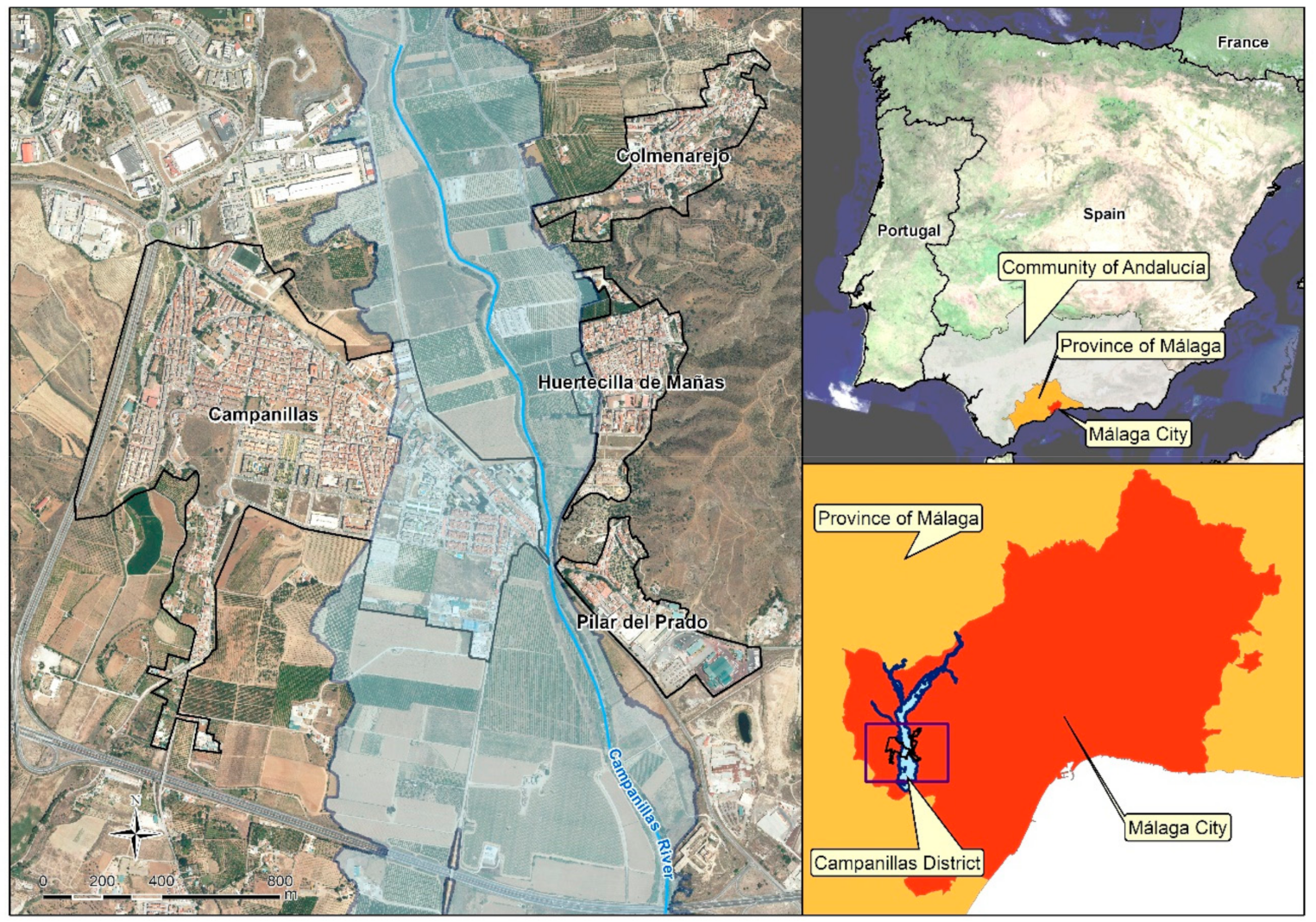
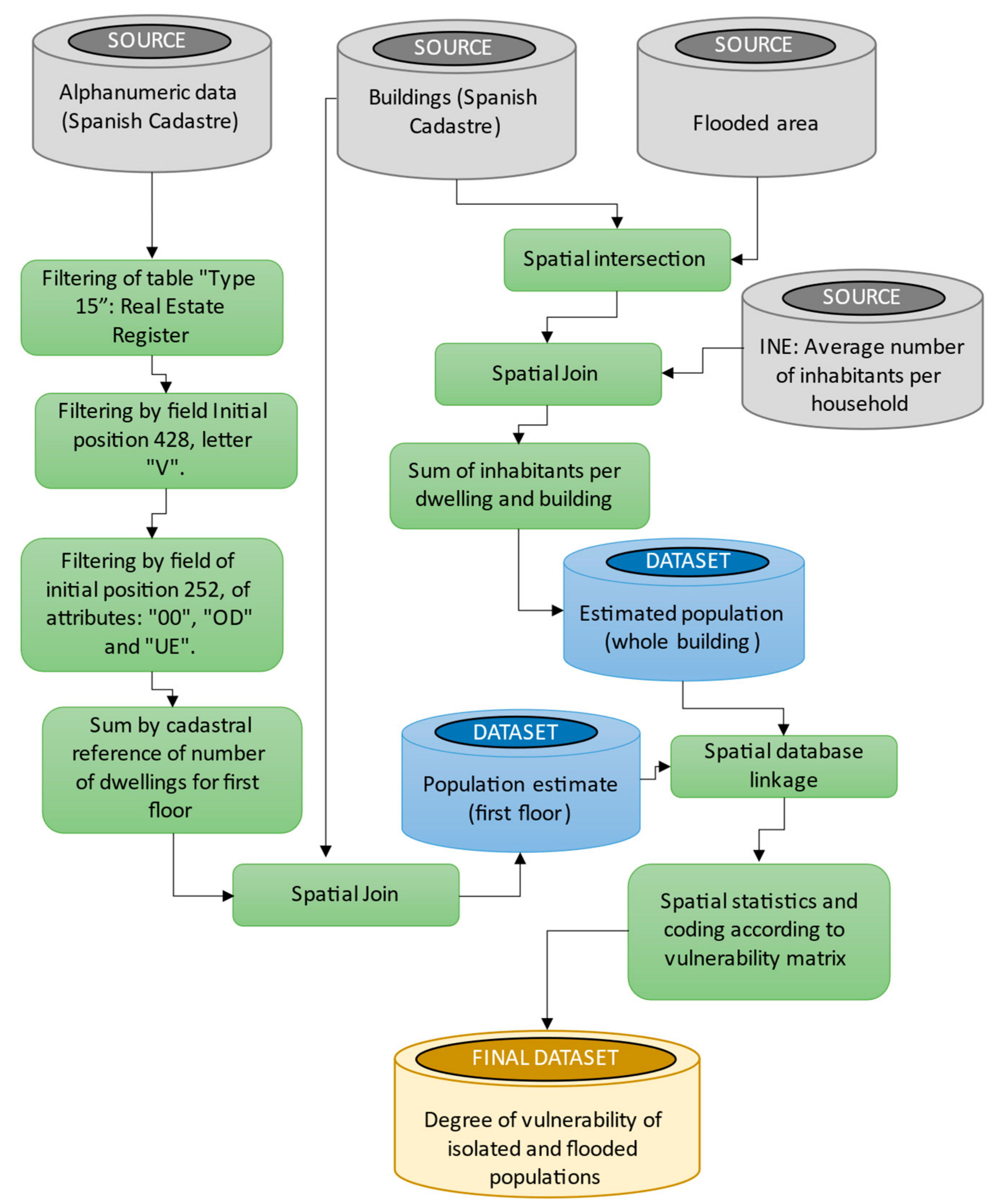
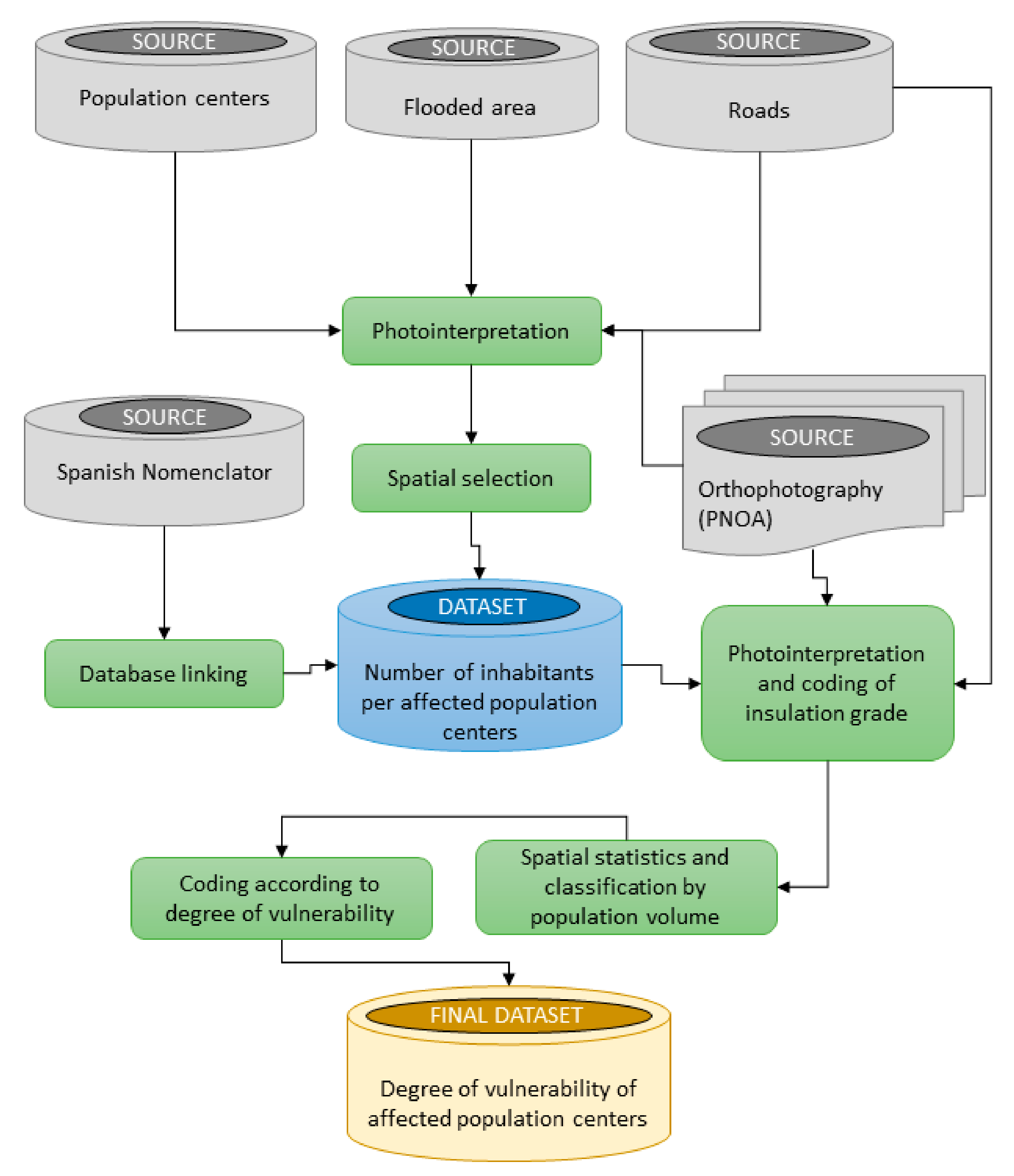
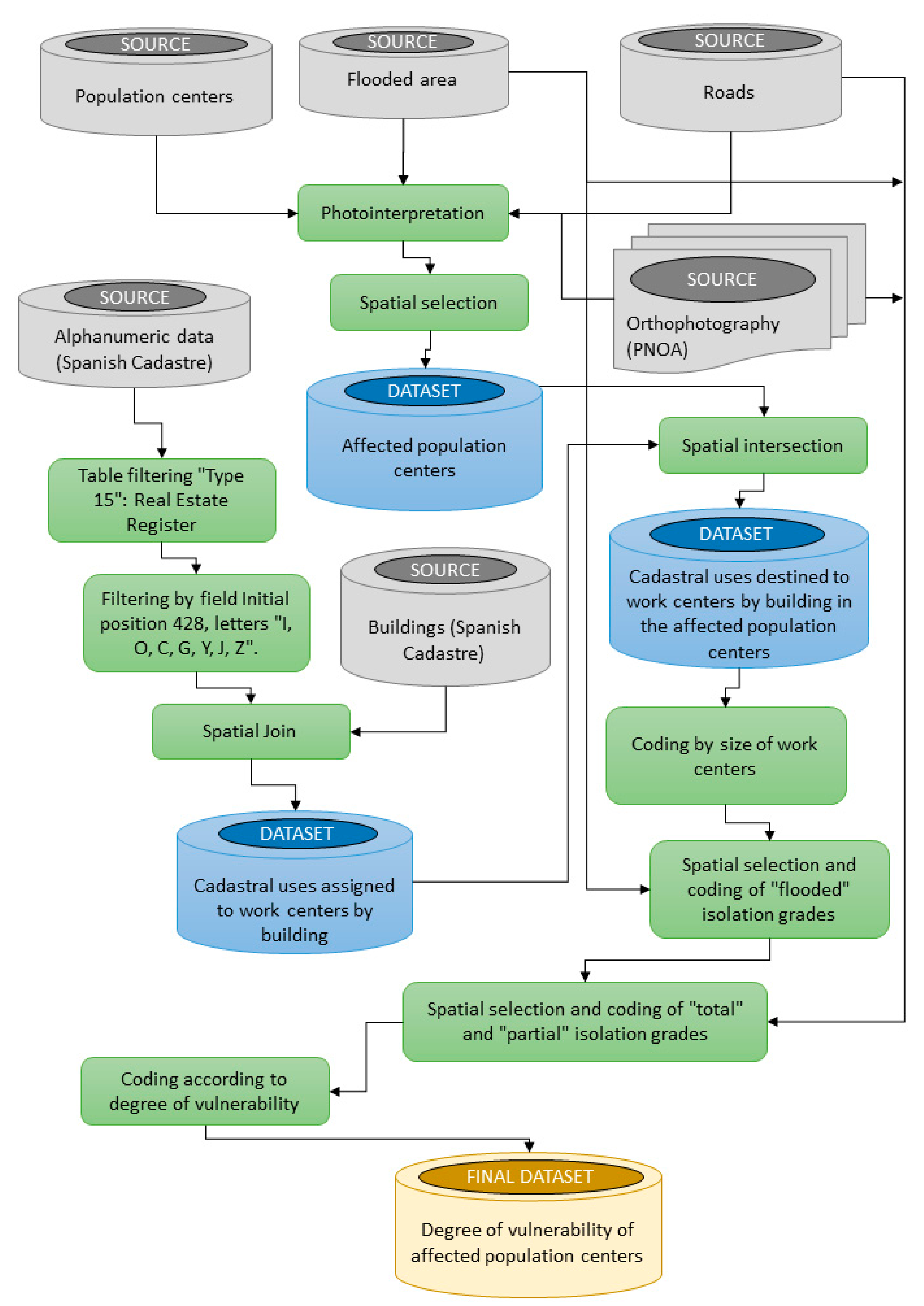
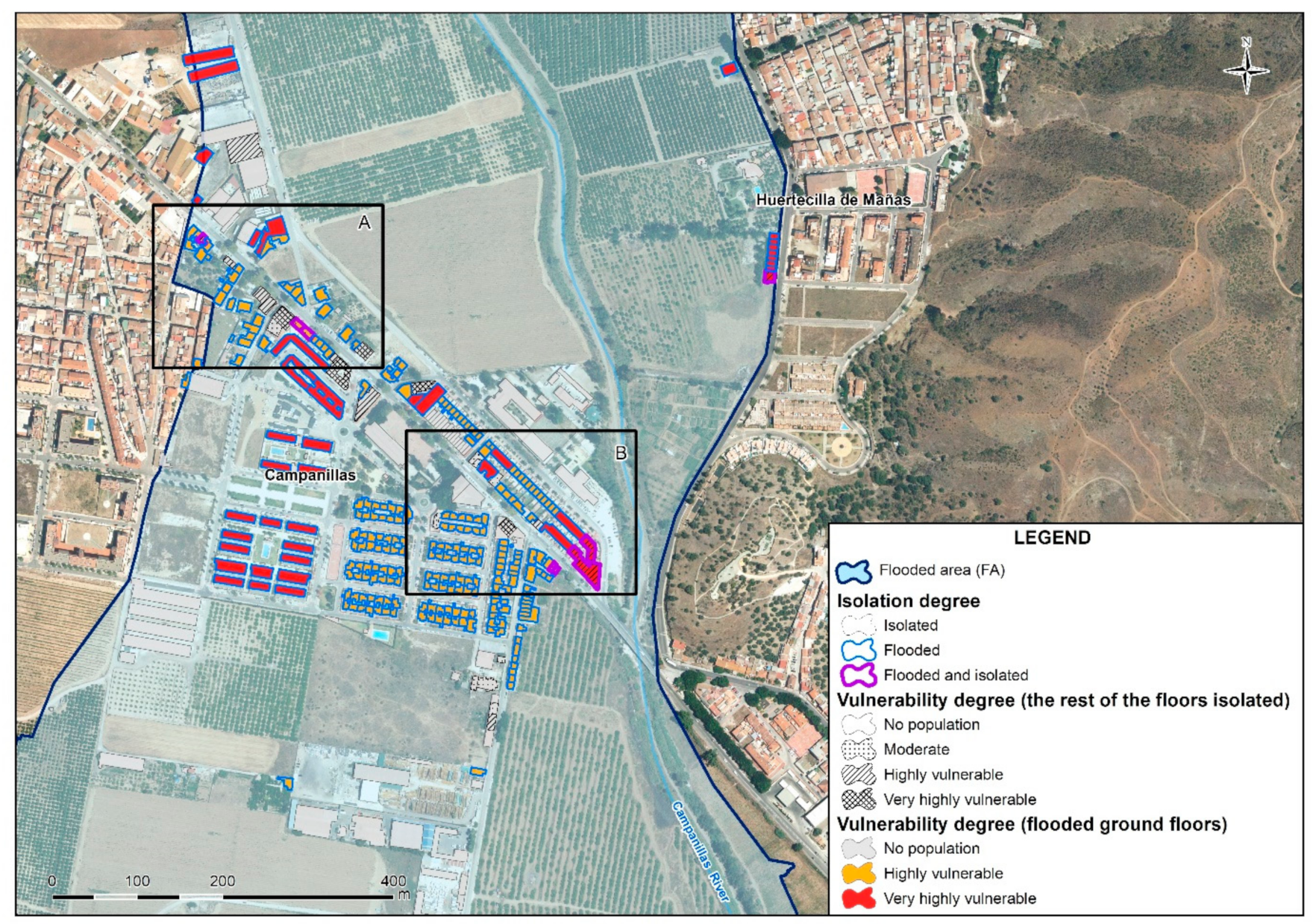
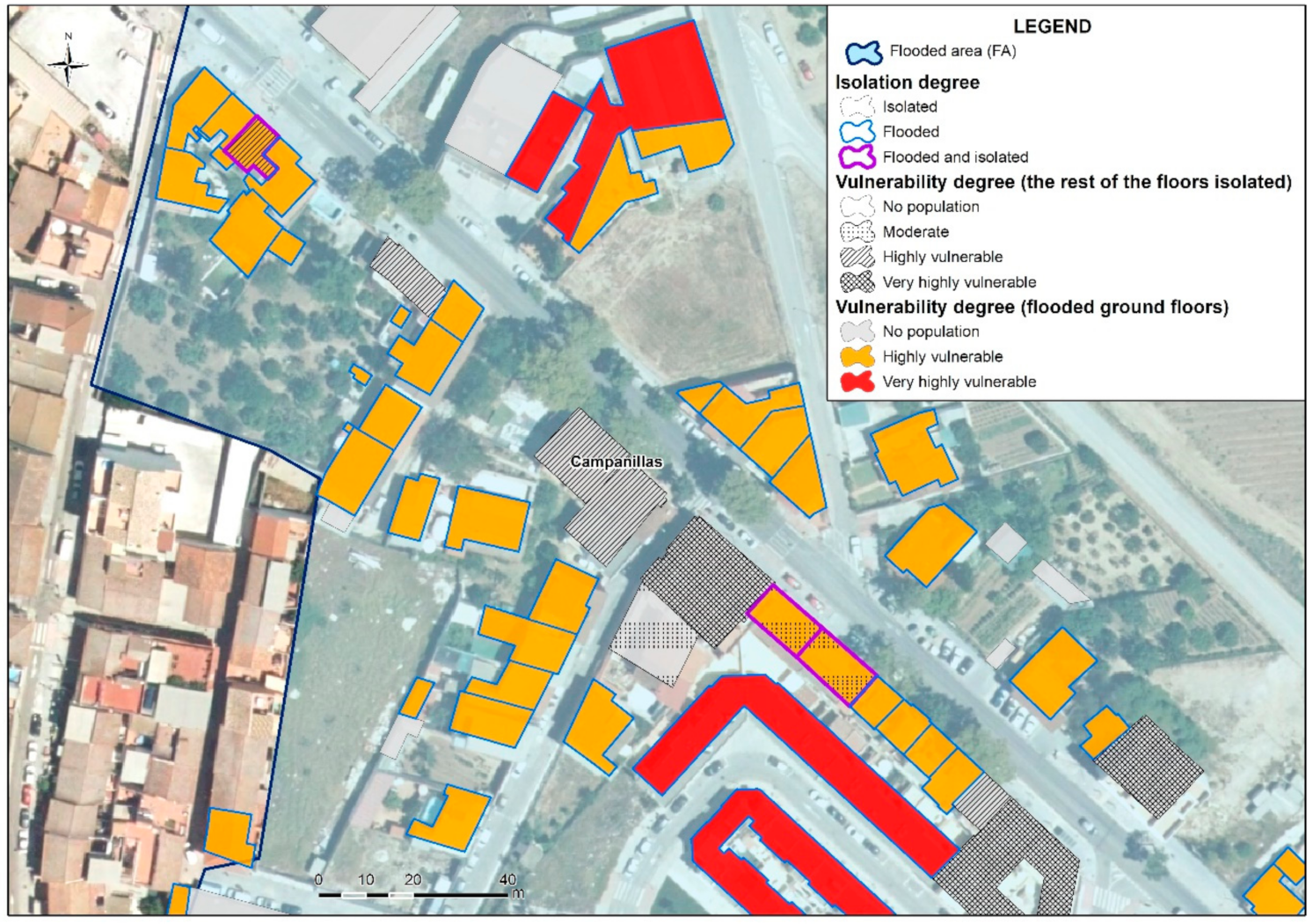
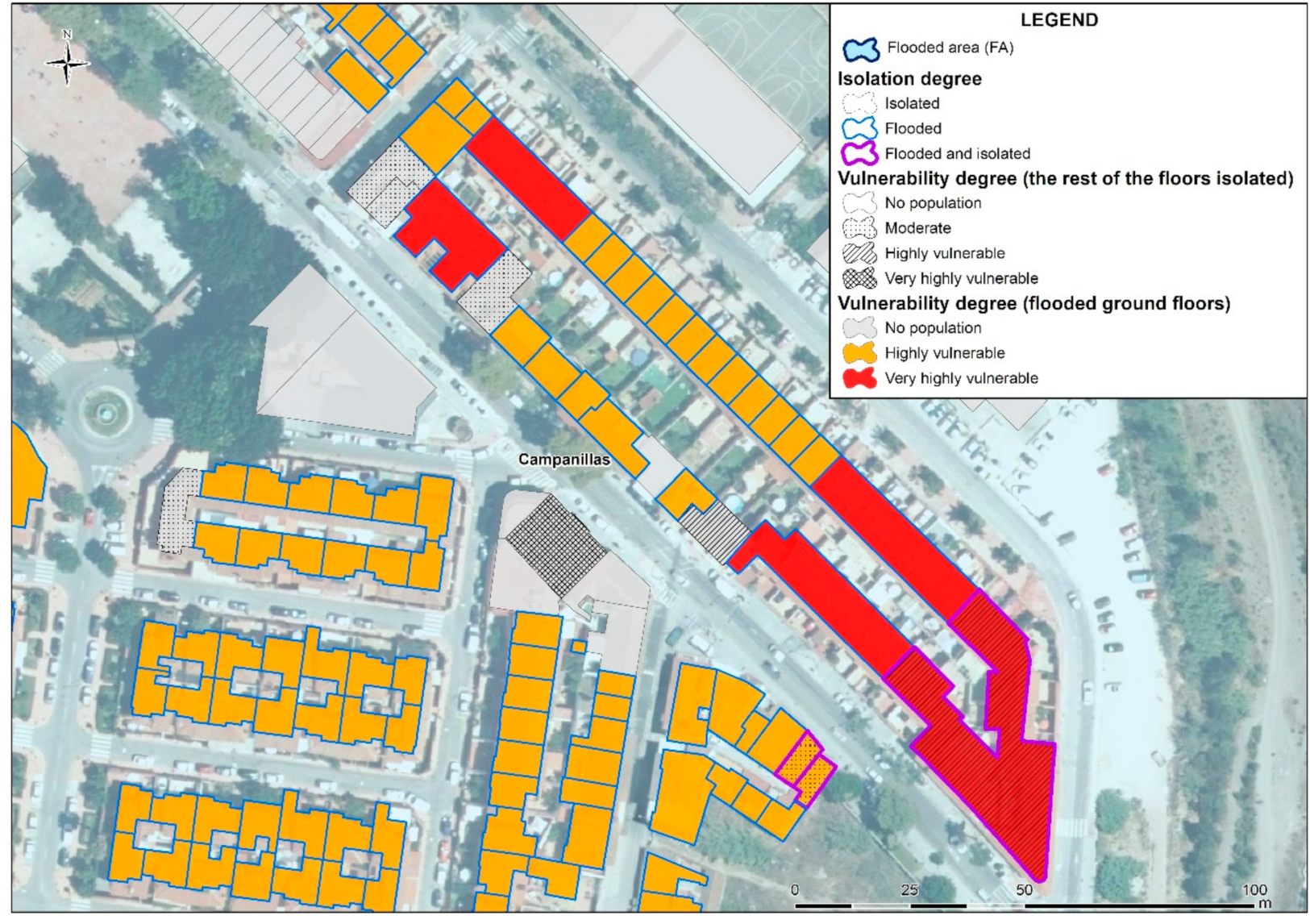
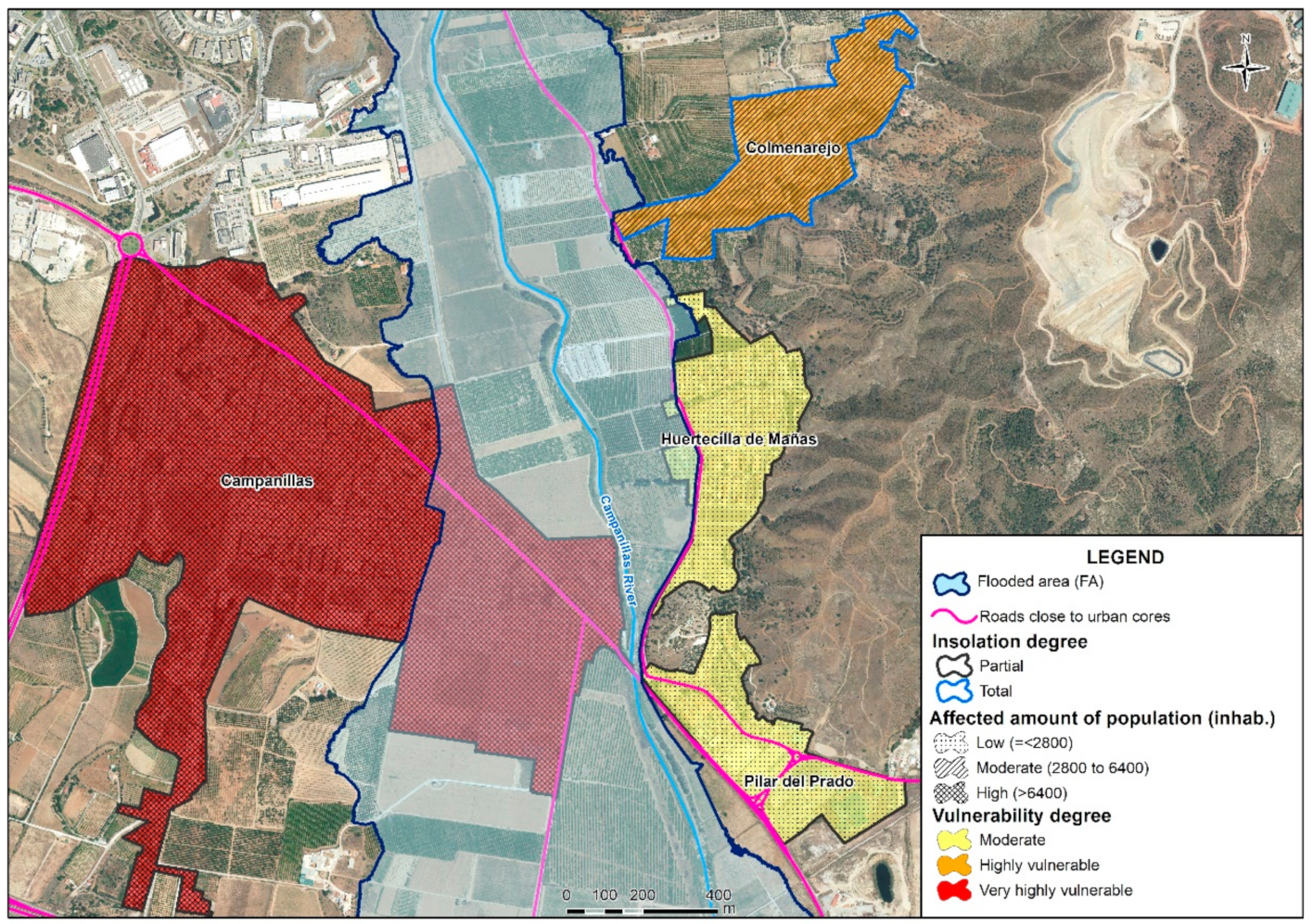
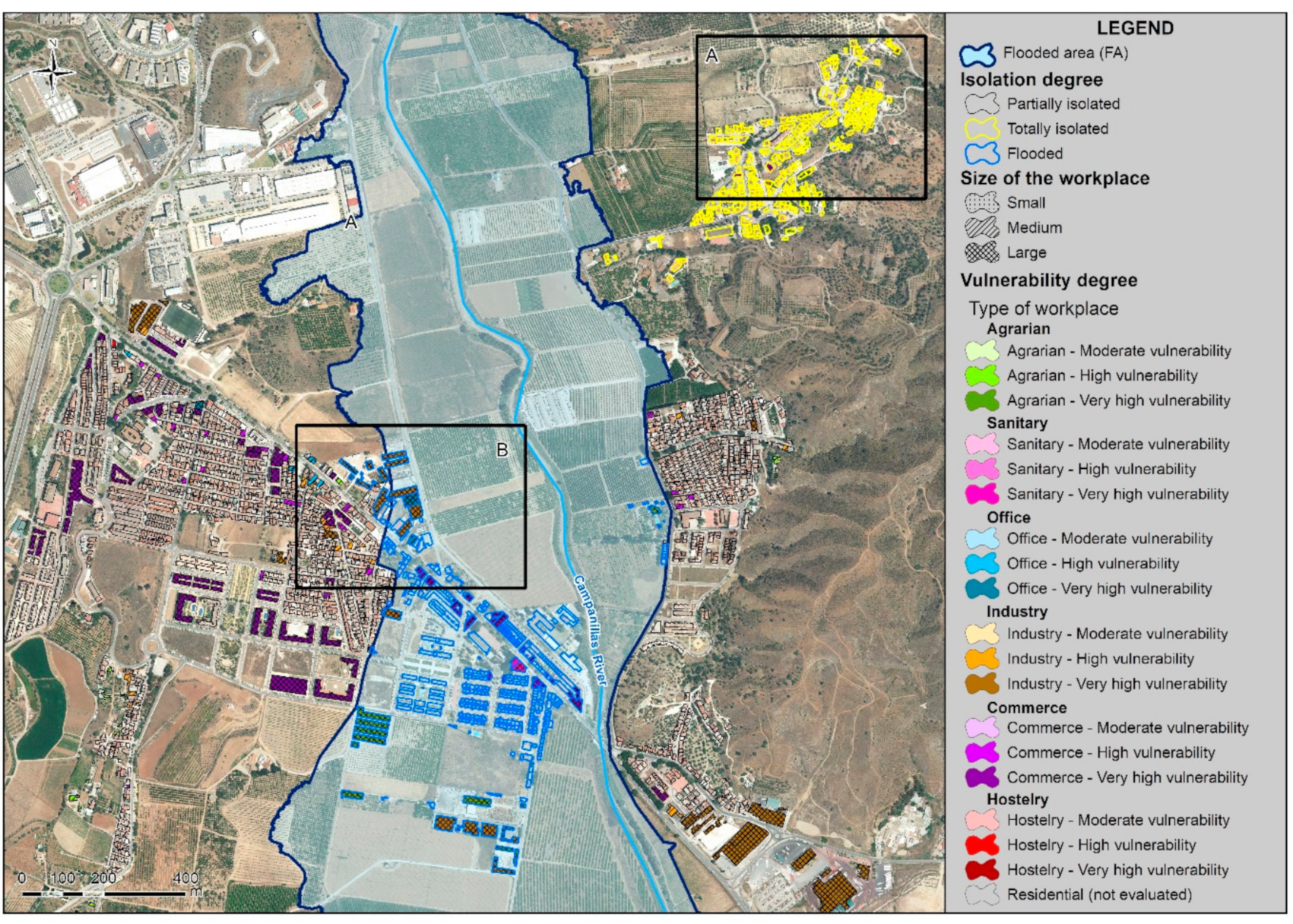

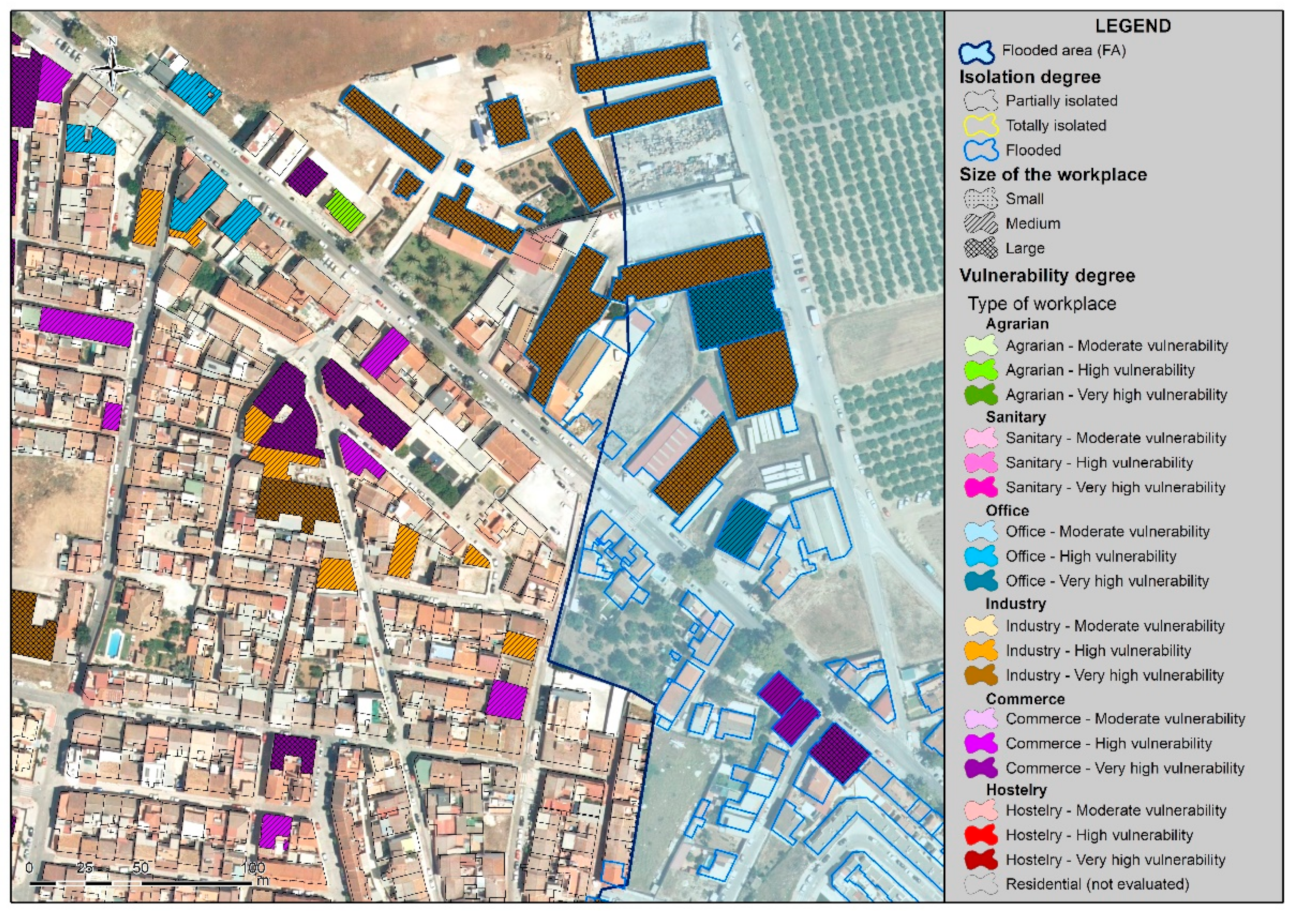
| Maps | Issues |
|---|---|
| Maps focus on solving issues related to vulnerability against hazard | Disruption of basic territorial services |
| Isolation of the population | |
| Relief and assistance challenges | |
| Risky or unsafe behavior of the population Information needs | |
| Effects on particularly sensitive goods or sectors of the territory | |
| Contamination and other flood-related hazards affecting parts of the territory | |
| Maps based on solving issues related to vulnerability, loss and recovery capacity | High replacement cost of property loss |
| Specific challenges for post-impact recovery |
| Population Unit | Urban Area (ha) | Flooded Area (ha) | Flooded Area (%) |
|---|---|---|---|
| Campanillas | 118.5 | 33.50 | 28.3 |
| Colmenarejo | 17.8 | 0.01 | 0.05 |
| Huertecilla de Mañas | 16.8 | 1.17 | 6.97 |
| Pilar del Prado | 14.9 | 0.00 | 0 |
| Census Section Code | Average Household Size by Census Section |
|---|---|
| 2906708064 | 1.52 inhab/home |
| 2906708064 | 2.71 inhab/home |
| Criteria for the Classification of Affected Population | Degree of Population Affected |
|---|---|
| Mean − 1 standard deviation | Low |
| Mean + 1 standard deviation | Moderate |
| Mean + 2 standard deviation | High |
| Estimation of the Population Affected per Building | ||||
|---|---|---|---|---|
| Low | Medium | High | ||
| High vulnerability | Very high vulnerability | Very high vulnerability | Flooded in situ | Degree of isolation |
| Moderate vulnerability | High vulnerability | Very high vulnerability | Isolated | |
| Province | Municipality | Population Unit | Total Population |
|---|---|---|---|
| 29 Málaga | 067 Málaga | 000101 Campanillas | 7303 |
| 29 Málaga | 067 Málaga | 000103 Colmenarejo | 760 |
| 29 Málaga | 067 Málaga | 000104 Huertecilla de Mañas | 1587 |
| 29 Málaga | 067 Málaga | 000105 Pilar del Prado | 398 |
| Criteria for the Classification of Urban Cores | Categorization of Urban Cores According to Their Population Size |
|---|---|
| Mean − 1 standard deviation | Low |
| Mean + 1 standard deviation | Moderate |
| Mean + 2 standard deviation | High |
| Gradation of Affected Population | ||||
|---|---|---|---|---|
| Low | Medium | High | ||
| High vulnerability | Very high vulnerability | Very high vulnerability | Totally isolated | Degree of isolation |
| Moderate vulnerability | High vulnerability | Very high vulnerability | Partially isolated | |
| Code | Use |
|---|---|
| A | Warehouse—Parking |
| V | Residential |
| I | Industrial |
| O | Offices |
| C | Commercial |
| K | Sporting |
| T | Performing arts |
| G | Leisure and hospitality |
| Y | Health and wellness |
| E | Cultural |
| R | Religious |
| M | Urbanization and landscaping works, undeveloped land |
| P | Singular building |
| B | Farm warehouse |
| J | Agrarian industrial |
| Z | Agrarian |
| Size of the Workplace | ||||
|---|---|---|---|---|
| Small | Medium | Large | ||
| Very high vulnerability | Very high vulnerability | Very high vulnerability | Flooded in situ | Degree of isolation |
| High vulnerability | Very high vulnerability | Very high vulnerability | Totally isolated | |
| Moderate vulnerability | High vulnerability | Very high vulnerability | Partially isolated | |
| Mean (±) Standard Deviation | Classification Thresholds | Number of Population Affected |
|---|---|---|
| Mean (2.5 inhab./building) −1 standard deviation (3.5 inhab./building) | ≤2.5 inhab./building | Low |
| Mean (2.5 inhab./building) +1 standard deviation (3.5 inhab./building) | 2.5–6 inhab./building | Moderate |
| Mean (2.5 inhab./building) +2 standard deviation (7 inhab./building) | >6 inhab./building | High |
| Criteria for the Classification of Urban Cores | Categorization of Urban Cores According to Population Size |
|---|---|
| Mean (2800) − 1 standard deviation (3600) ≤ 2800 inhab. | Low |
| Mean (2800) + 1 standard deviation (3600) = 2800 to 6400 inhab. | Moderate |
| Mean (2800) + 2 standard deviation (7200) ≥ 6400 inhab. | High |
Publisher’s Note: MDPI stays neutral with regard to jurisdictional claims in published maps and institutional affiliations. |
© 2022 by the authors. Licensee MDPI, Basel, Switzerland. This article is an open access article distributed under the terms and conditions of the Creative Commons Attribution (CC BY) license (https://creativecommons.org/licenses/by/4.0/).
Share and Cite
Sortino Barrionuevo, J.F.; Castro Noblejas, H.; Cantarero Prados, F.J. Vulnerability to Flood Risk: A Methodological Proposal for Assessing the Isolation of the Population. Land 2022, 11, 277. https://doi.org/10.3390/land11020277
Sortino Barrionuevo JF, Castro Noblejas H, Cantarero Prados FJ. Vulnerability to Flood Risk: A Methodological Proposal for Assessing the Isolation of the Population. Land. 2022; 11(2):277. https://doi.org/10.3390/land11020277
Chicago/Turabian StyleSortino Barrionuevo, Juan Francisco, Hugo Castro Noblejas, and Francisco José Cantarero Prados. 2022. "Vulnerability to Flood Risk: A Methodological Proposal for Assessing the Isolation of the Population" Land 11, no. 2: 277. https://doi.org/10.3390/land11020277







